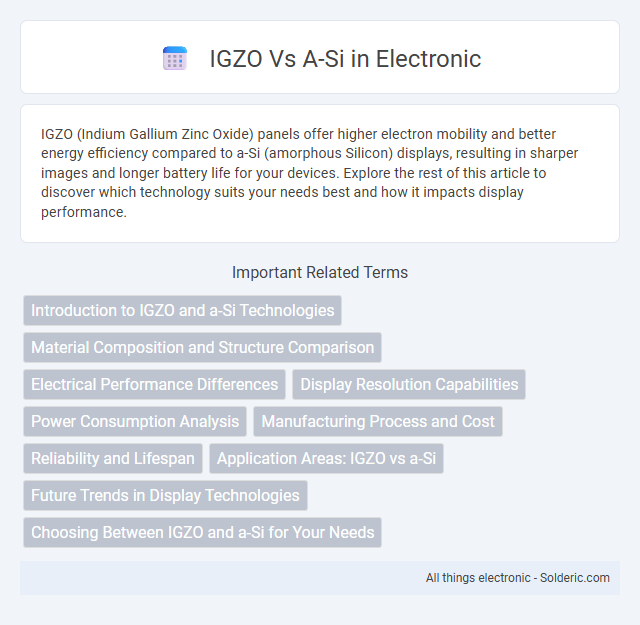IGZO (Indium Gallium Zinc Oxide) panels offer higher electron mobility and better energy efficiency compared to a-Si (amorphous Silicon) displays, resulting in sharper images and longer battery life for your devices. Explore the rest of this article to discover which technology suits your needs best and how it impacts display performance.
Comparison Table
| Feature | IGZO (Indium Gallium Zinc Oxide) | a-Si (Amorphous Silicon) |
|---|---|---|
| Material Composition | Indium, Gallium, Zinc, Oxygen | Silicon (amorphous form) |
| Electron Mobility | 10-20 cm2/V*s (high) | 0.5-1 cm2/V*s (low) |
| Display Type | High-resolution LCD, OLED | Standard LCD |
| Power Consumption | Lower power consumption | Higher power consumption |
| Resolution Support | Supports high pixel density (4K and beyond) | Limited to lower resolutions |
| Stability | Better stability and performance | More prone to degradation |
| Cost | Higher manufacturing cost | Lower manufacturing cost |
| Applications | Smartphones, tablets, high-end TVs | Standard monitors, budget devices |
Introduction to IGZO and a-Si Technologies
IGZO (Indium Gallium Zinc Oxide) and a-Si (amorphous Silicon) are two key thin-film transistor (TFT) technologies used in display panels, with IGZO offering higher electron mobility and better energy efficiency compared to a-Si. IGZO's superior electrical properties enable higher resolution, faster response times, and enhanced image quality in LCD and OLED screens, making it suitable for high-performance devices. Your choice between IGZO and a-Si impacts display brightness, power consumption, and overall device durability.
Material Composition and Structure Comparison
IGZO (Indium Gallium Zinc Oxide) is a ternary oxide semiconductor composed of indium, gallium, zinc, and oxygen atoms arranged in an amorphous structure, providing high electron mobility and uniform electrical characteristics. In contrast, a-Si (amorphous silicon) consists of silicon atoms in a disordered non-crystalline network with lower electron mobility and greater susceptibility to defects. The unique metal oxide composition of IGZO enables superior electrical performance and stability compared to the silicon-based a-Si used in thin-film transistors for displays.
Electrical Performance Differences
IGZO (Indium Gallium Zinc Oxide) exhibits significantly higher electron mobility than a-Si (amorphous Silicon), resulting in faster switching speeds and improved electrical conductivity. In display applications, IGZO enables lower power consumption and enhanced image resolution due to its superior current stability and reduced leakage currents. Your devices featuring IGZO TFTs benefit from sharper visuals and longer battery life compared to those using traditional a-Si technology.
Display Resolution Capabilities
IGZO (Indium Gallium Zinc Oxide) technology offers significantly higher display resolution capabilities compared to a-Si (amorphous Silicon) due to its superior electron mobility, which enables faster pixel switching and finer control over individual pixels. This results in sharper images and more detailed visuals, enhancing the overall user experience on devices like smartphones, tablets, and monitors. Investing in IGZO panels ensures your display can achieve higher pixel densities and improved clarity essential for 4K and beyond resolution standards.
Power Consumption Analysis
IGZO (Indium Gallium Zinc Oxide) displays consume significantly less power compared to a-Si (amorphous Silicon) due to higher electron mobility, which enables faster switching at lower voltage levels. The lower off-current leakage in IGZO panels translates to improved energy efficiency and longer battery life in devices such as smartphones and tablets. Choosing IGZO technology for your display can reduce power consumption by up to 50%, making it ideal for portable electronics requiring extended usage.
Manufacturing Process and Cost
IGZO (Indium Gallium Zinc Oxide) displays a more complex and costly manufacturing process compared to a-Si (amorphous Silicon) due to its use of advanced sputtering techniques and precise control over material composition. While a-Si benefits from mature, low-temperature PECVD (Plasma Enhanced Chemical Vapor Deposition) methods that are less expensive and widely adopted in large-scale production, IGZO's higher performance demands lead to increased fabrication costs. Your choice between IGZO and a-Si should consider the balance of superior display characteristics against manufacturing expenses and production scalability.
Reliability and Lifespan
IGZO (Indium Gallium Zinc Oxide) displays superior reliability and longer lifespan compared to a-Si (amorphous Silicon) due to its higher electron mobility and better stability under electrical stress. IGZO's robust performance mitigates threshold voltage shifts and prolongs display functionality, especially in high-resolution and high-refresh-rate applications. In contrast, a-Si suffers from faster degradation and increased susceptibility to image retention, limiting its durability in demanding environments.
Application Areas: IGZO vs a-Si
IGZO (Indium Gallium Zinc Oxide) technology is widely used in high-resolution displays such as smartphones, tablets, and premium televisions due to its superior electron mobility and energy efficiency. In contrast, a-Si (amorphous Silicon) remains dominant in large-area, cost-sensitive applications like standard LCD panels for monitors, televisions, and digital signage because of its lower manufacturing cost and mature production processes. IGZO's enhanced performance in pixel switching speed and power consumption makes it especially suitable for high-refresh-rate displays and flexible electronics, where a-Si's slower response limits usage.
Future Trends in Display Technologies
IGZO (Indium Gallium Zinc Oxide) technology offers higher electron mobility and improved energy efficiency compared to a-Si (amorphous Silicon), positioning it as a key player in future display innovations. Emerging display technologies increasingly adopt IGZO for sharper image quality and longer battery life, especially in high-resolution smartphones, tablets, and OLED panels. Your choice in display technology can benefit from IGZO's advantages as demand grows for more vibrant and power-efficient screens.
Choosing Between IGZO and a-Si for Your Needs
IGZO (Indium Gallium Zinc Oxide) offers higher electron mobility and better energy efficiency compared to a-Si (amorphous Silicon), making it ideal for high-resolution displays and devices requiring longer battery life. a-Si remains a cost-effective choice with simpler manufacturing processes, suitable for budget-conscious applications with moderate display performance requirements. Your choice between IGZO and a-Si depends on prioritizing display quality and power efficiency versus lower production costs.
IGZO vs a-Si Infographic

 solderic.com
solderic.com